The title is a heroicomic paraphrase of a well-known poem by Leopardi. The song is nocturnal because the hours of silence are those of memory, of distant contemplation of a lived reality that remains as a vanished pattern. The Honorary Inspector today is a hazily Gogolian character, or a cautionary Shakespearean ghost standing in “another world” whence he speaks without more imperium. On MiBACT’s remaining papers he is still called that! But why is he wandering through the air? Because he no longer knows what he really is, what he can do and how to affect social realities to protect Cultural Heritage, to locate it more and more, to mark and defend it: in the landscape, in environmental complexes, in historic buildings, in traditional construction, in artisans’ workshops, in libraries, in archives and collections, and everywhere.
The Inspector knows that the defense must take place at institutions and private individuals, especially in conjunction with municipal and other public and religious offices. All this in the cities fractious with modern life, but also in the villages, in the countryside, in the Italy “of hamlets and altarpieces” as Pasolini used to say, in the most lived-in places and in the remote and scattered ones.
After the Unification of Italy, the Superintendents and Inspectors were almost all “honorary,” that is, people trained in history and the arts who acted in the name of the Ministry (of Public Education) without salary roles, and who helped save and direct countless heritages often of high value, with enormous merit. But let us not forget their defeats: over distinguished monuments, over valuable environmental paintings in a great many places, over the urban development of almost all Italian towns, over frescoes and worked stone; and also over collections and works that have dispersed or fled.
In the last postwar period, the Honorary Inspectors had a not insignificant role given the official weakness of the Superintendencies, but by virtue of those binding aspects that the 1939 Works of Art Law made at least fearful of the torrents of building contractors and art trade pimps; local administrators also paid attention to the “opinions” of the Superintendencies that came precisely from the Honorary Inspectors acting in the territory. The greater municipalities established the presence of a “representative of the Superintendence of Monuments” in the Building Commissions, real prospecting booths on the urbanization movements that pressed terribly on all sides. Then the nuisance of such opinions caused the Superintendence representative to be replaced by (hear!) a labor union representative; or the rules of the Commissions themselves were changed so that matters proceeded more expeditiously “by area and cubage.” Urban suburbs became a caravanserai of concrete shelving, often unacceptably conculcating basic social needs; and the countryside was considered a “white zone” in which almost any operation could then take place. A kind of death of civilization!
On movable property it is almost superfluous to say that a great many small private heritages of paintings, sculptures, ceramics, book and archival collections, tools, which only the knowledge of a local inspector could reach and judge, were dispersed. In this way, the function of “identity assets” was weakened in the very season in which the Italian Constitution indicated their values and defense. The dispersions also severely depressed social memory and the possibility of teaching, through them, the younger generations in the various civilized areas. The tradition of donations to local Museums was severely brought down, because it was not motivated by the constant convincing operation that local Inspectors knew how to do and spread.
The above picture leads to an open and painful realization. Today the Ministry of Cultural Heritage in Italy is a ministry without an army !
Nowadays, even smaller municipalities set up voluntary Ecological Guards: an excellent thing. What about the Beni? The Honorary Inspectors are either no longer there, or they count for nothing. The nothingness lies with the Superintendencies themselves and the others the ministerial steps; they certainly have no weight with the local administrations (eight thousand municipalities in Italy) and with the population. This is due to the lack of authority! The Shakespearean ghost we evoked earlier is no longer even cautionary: it has been erased!
The writer has been engaged on the Beni with remarkable intensity throughout the territory of his own region, Emilia-Romagna: the directly piloted research and documentation series, conducted with the collaboration of celebrated scholars and teachers and many local scholars; flowing from the deepest samplings of artifacts, folk crafts, territorial usages up to the high artistic and intellectual workshops, bear witness to this. Now it is facing the physiological death of the Region’s Institute of Cultural and Natural Heritage, which is happening (apart from the fine lip-service cover-ups) by inincidence on the behavior of the Local Authorities. A missed aim and an inevitable result. Yet the writer undertook to provide the Institute with theAtlas of the Cultural Heritage of Emilia Romagna in four large, illustrated, demonstrative volumes.
A demise then, that of the vaunted IBC, with no condolences whatsoever. And the various Culture Councillors of our municipalities either remain entangled in sports, rock music, hunting and fishing and leisure, or are even relegated behind other shoulders. But almost no one gets a culture about the Assets and their enhancement in a real educational sense in their territory.
Does the minister who was of MiBACT and is now of Culture notice the serious state of national degrading? Does he notice that he does not have an army? Do not believe that career inspectors are sufficient or effective: they are not at all. They are few in number, they are often “foreign” to the local culture, they change regions, and too often are never seen! It is touching to see certain rare rounds of first-appointed “forest” Inspectors, who look at problems with rambling eyes and stammer a few judgments and then disappear. And enough of the “foreign” Regional Hub Managers: it makes no sense!
I believe that the composition of a national network of Honorary Inspectors is an important step, as long as they are selected with real experience, with precise skills with legal ability to inspect, with force of first prohibition, first constraint, examining projects, assisting with restorations, and being present at Schools and High Schools. And it must be clear that they are really Inspectors within the Administration, with equal dignity to career inspectors. It is necessary that badges no longer have a three-year expiration; an expiration that is always humiliating and causes very large gaps in effectiveness and dropouts. The Honorary Inspector must enjoy official Ministry reporting to the Public, Military and Religious Bodies in his area. It will lapse, if appropriate, by specific act of replacement. A large area Board of Inspectors will be composed with ad hoc regulations. Superintendents will convene and visit their Inspectors. I will not dwell on these aspects that we had partly experimented with and will have to be codified, but I pose one of the most serious problems for our country. And I await a call from the Minister.
Then there remains the need for the Ministry to explicitly recognize the role of Art Education and Art History Teachers in the various orders of Education: they are the cornerstones of the education of a people: here an immense discourse must open, even of legislative recognition.
I follow in photographs three painfully exemplary cases: all in a “small town” with a noble history that is not named. Cases that are innumerably repeated in Italy.
Note. The writer was appointed Honorary Inspector in 1967 then constantly renewed. He has cared for and spread the knowledge of Cultural Heritage in teaching, inspections, reports, restorations; also in dozens of large and organic publications, and in countless conferences. He has worked and collaborated with the finest names in Italian culture. Now the call also goes back to the many cries rising from many quarters.) Images follow, from a small, unnamed town.
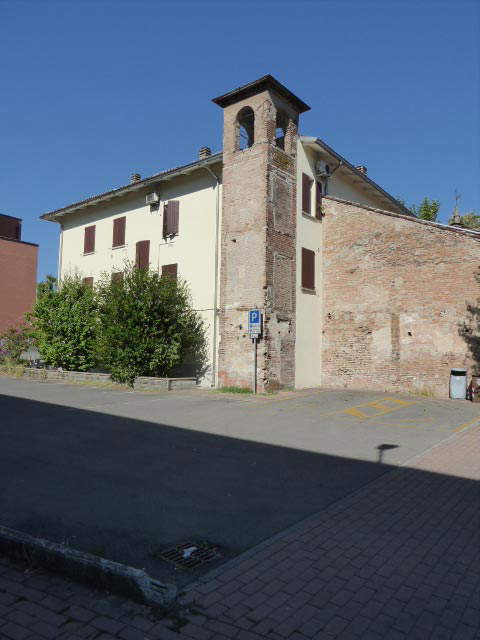 |
| One can see the small Church, once of the Hospitaller Orders, already packed among other buildings but abandoned. Recently the whole adjacent area has become a huge residential and commercial patchwork, named after the very title of the Church itself. The historic building in its presence dates back to the 15th and 16th centuries, held the adjacent shelter and bore its pilgrim heraldic coat of arms. Of all the economic bulk by which it has been surrounded it seems that nothing has been committed to its minimal and decorous restoration: for those who now arrive next to the great Hospital it thus remains as an unseemly testimony to a community lacking in consciousness of assets. |
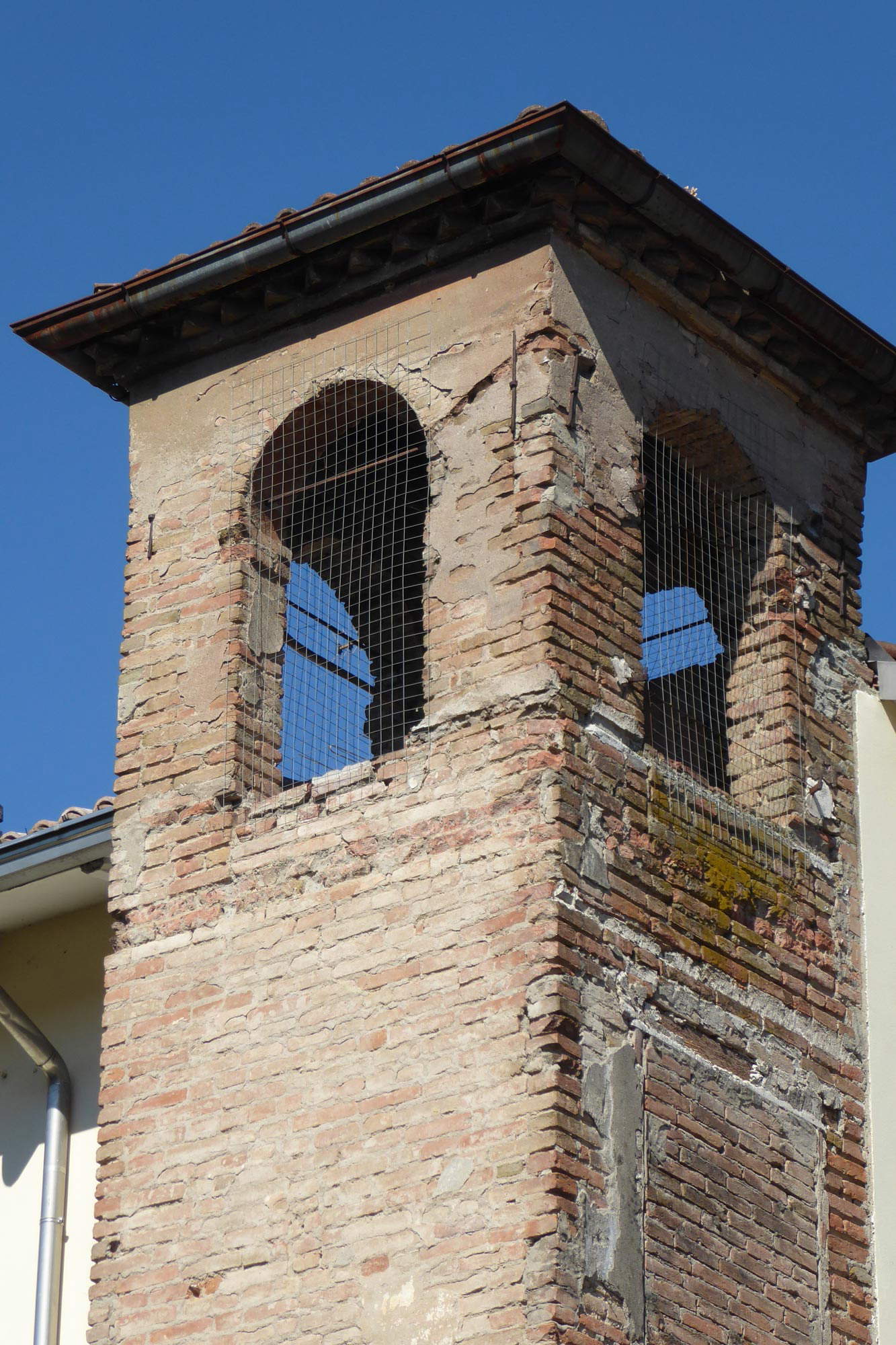 |
| The tower of the Hospitaller Church. The state of neglect, now alarming in a physical and symbolic sense, is most evident. |
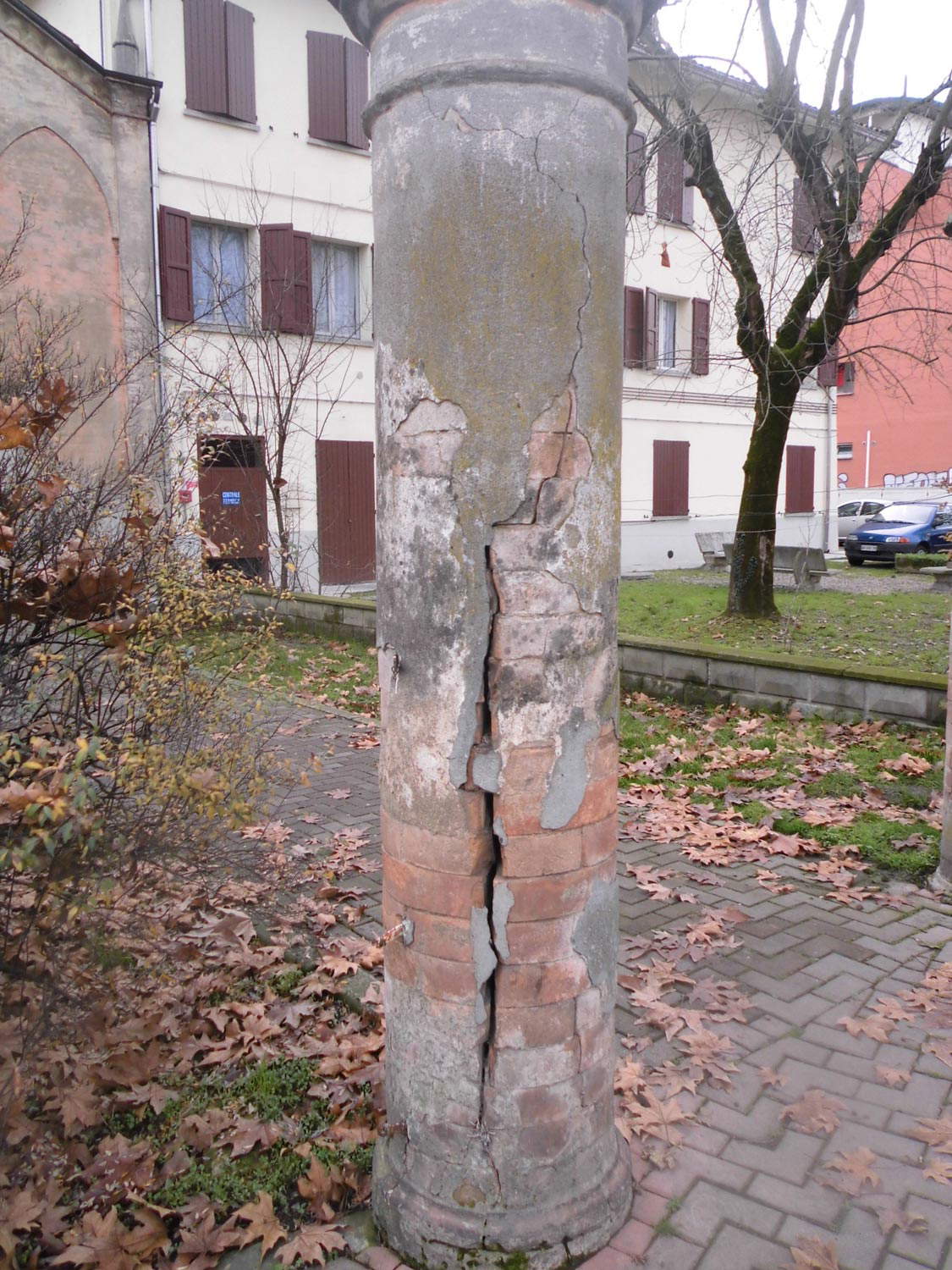 |
| One of the pillars of the small churchyard of the Hospitaller Church. For some time, and despite repeated invitations, it has also been a public hazard in a busy passageway. |
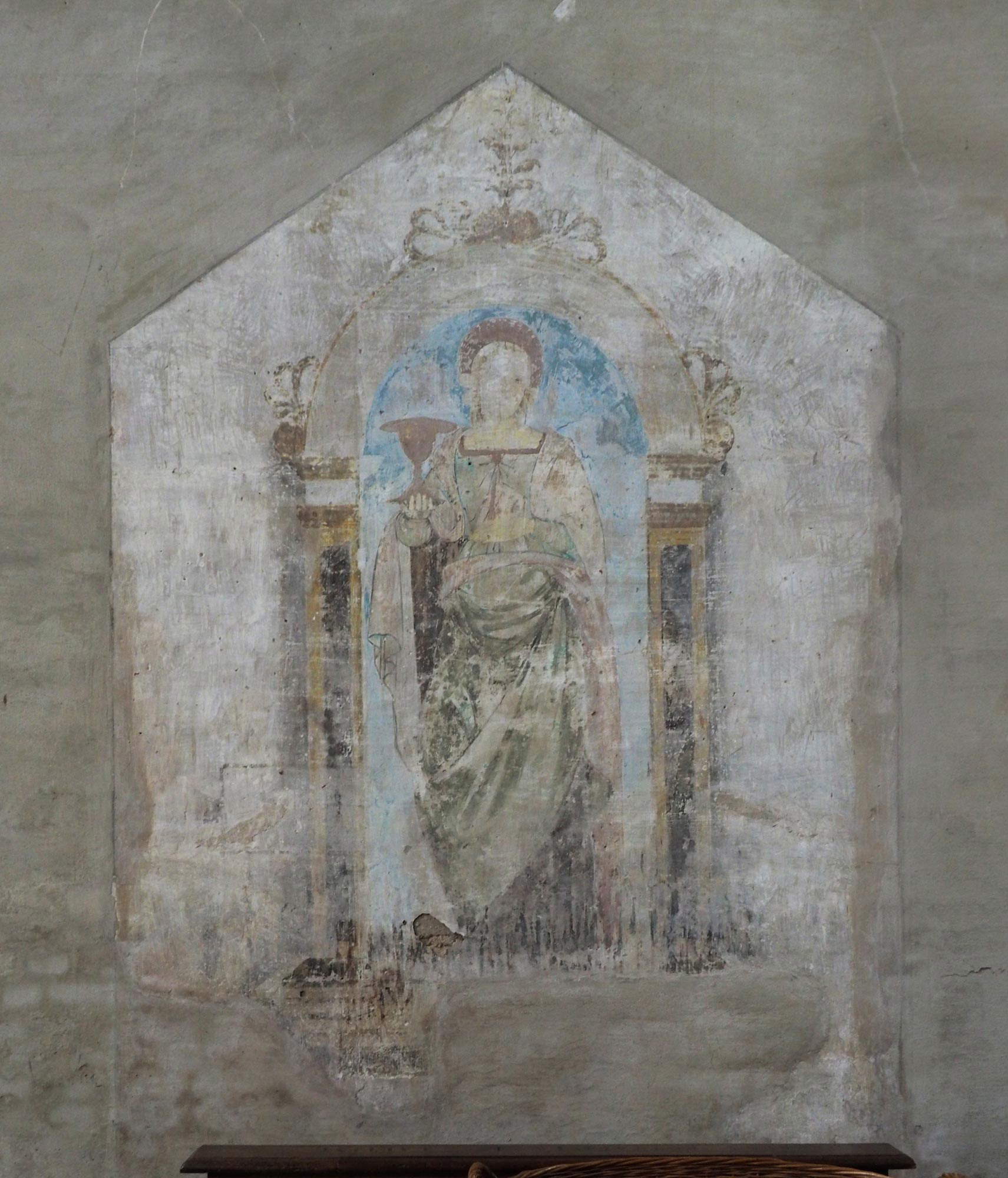 |
| Franciscan Church. Inside the communal church, this “poor” painting from the very early 1500s still peeps out, which is an extraordinary testimony to the early arrival of Perugian culture in the heart of Emilia. In years past there were fleeting appearances of Inspectors with the ballet of contradictory indications, and now for some time all has been still, with restoration interrupted, although sponsored by a willing Association. |
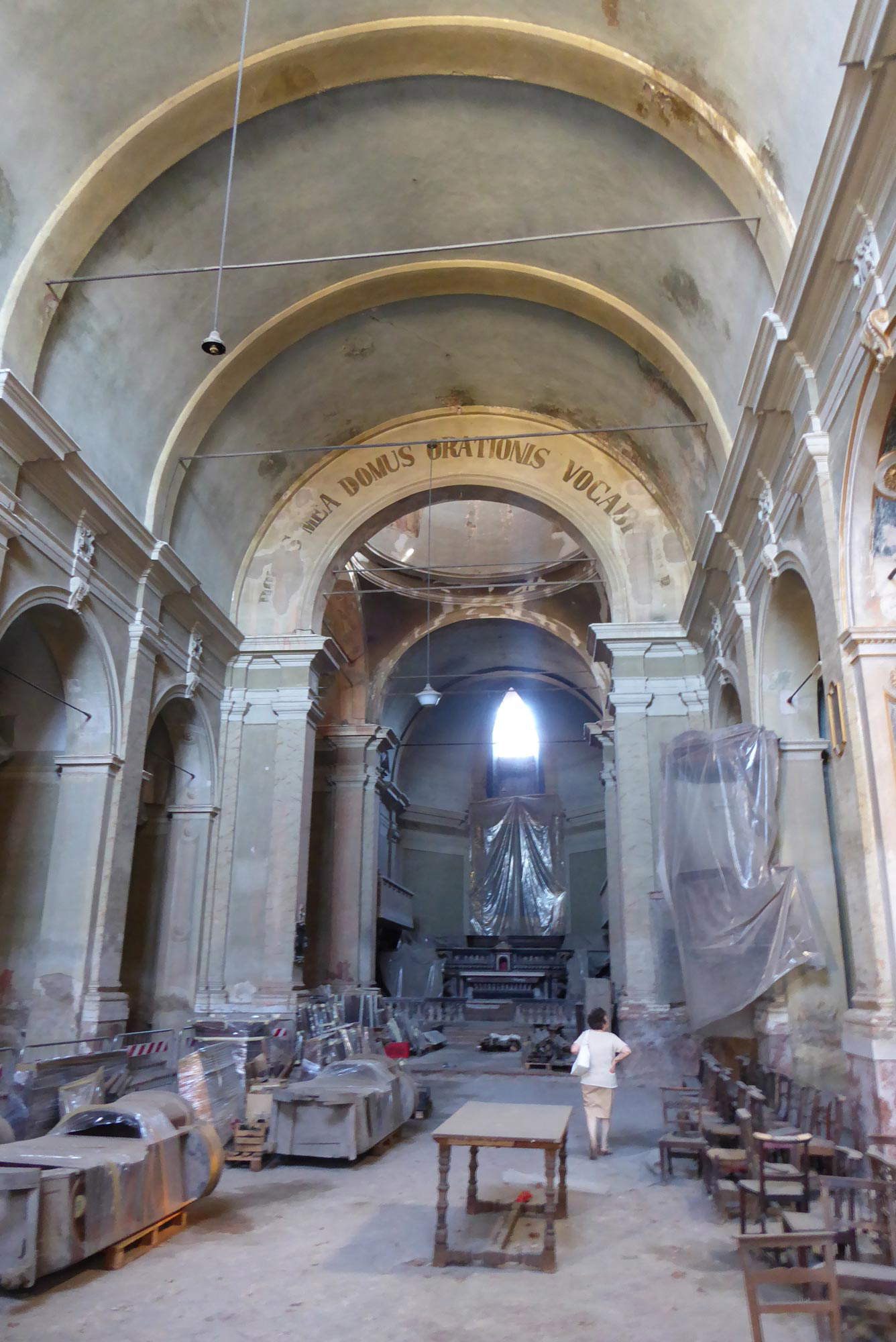 |
| The interior of the 17th-century Dominican Church. The movable paintings have been removed, but everything else passes into decay, such as the magnificent choir, the very rare organ, the scagliola palliotti, the wooden sculptures, the admirable frames and other furnishings. |
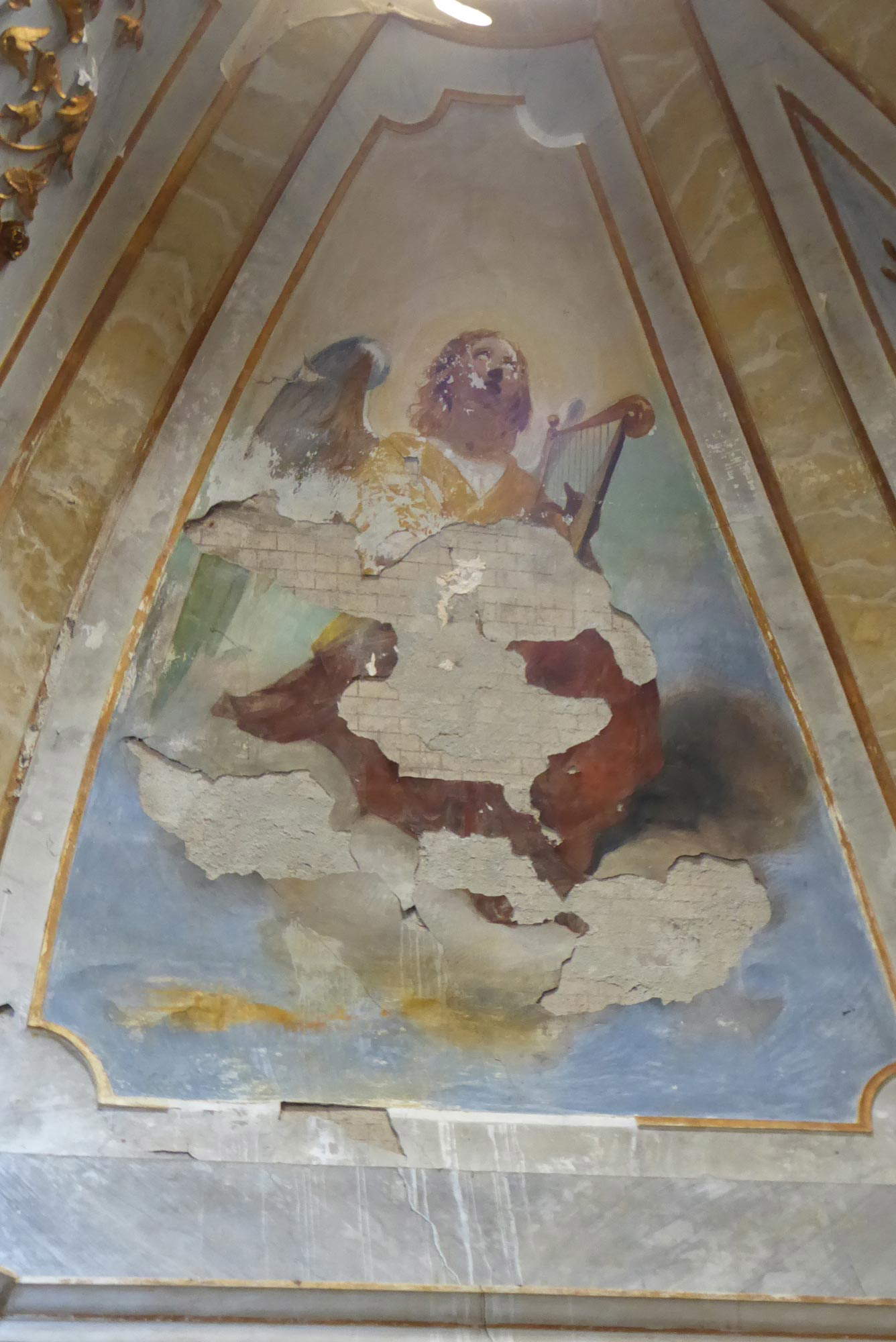 |
| Dominican Church. The wall paintings, still intact in the postwar years, now fall. |
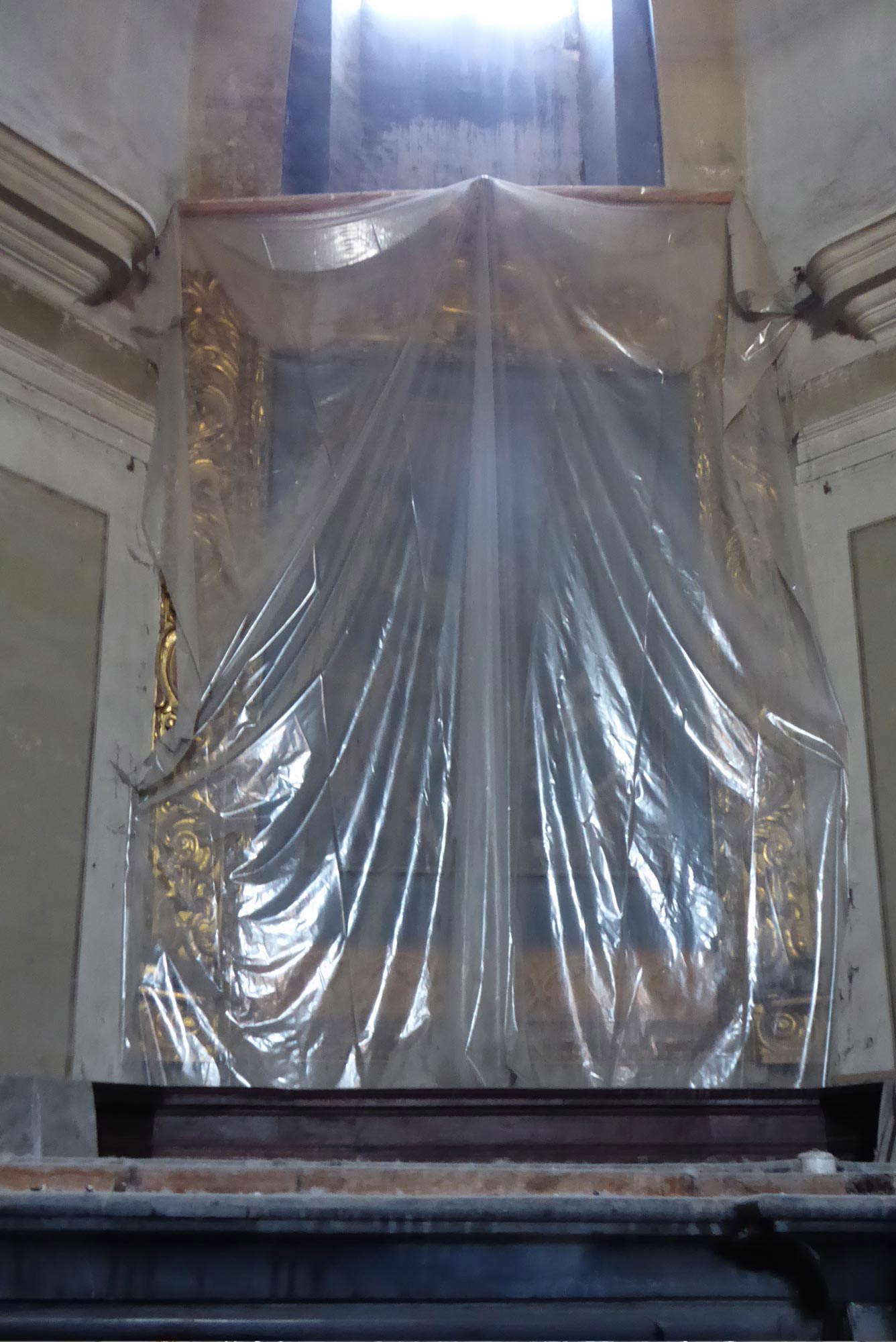 |
| Dominican Church. The grand and stupendous frame of the main altarpiece in wood and pure gold, an autograph work by Federico Zuccari, suffers increasing damage under the filtering window. |
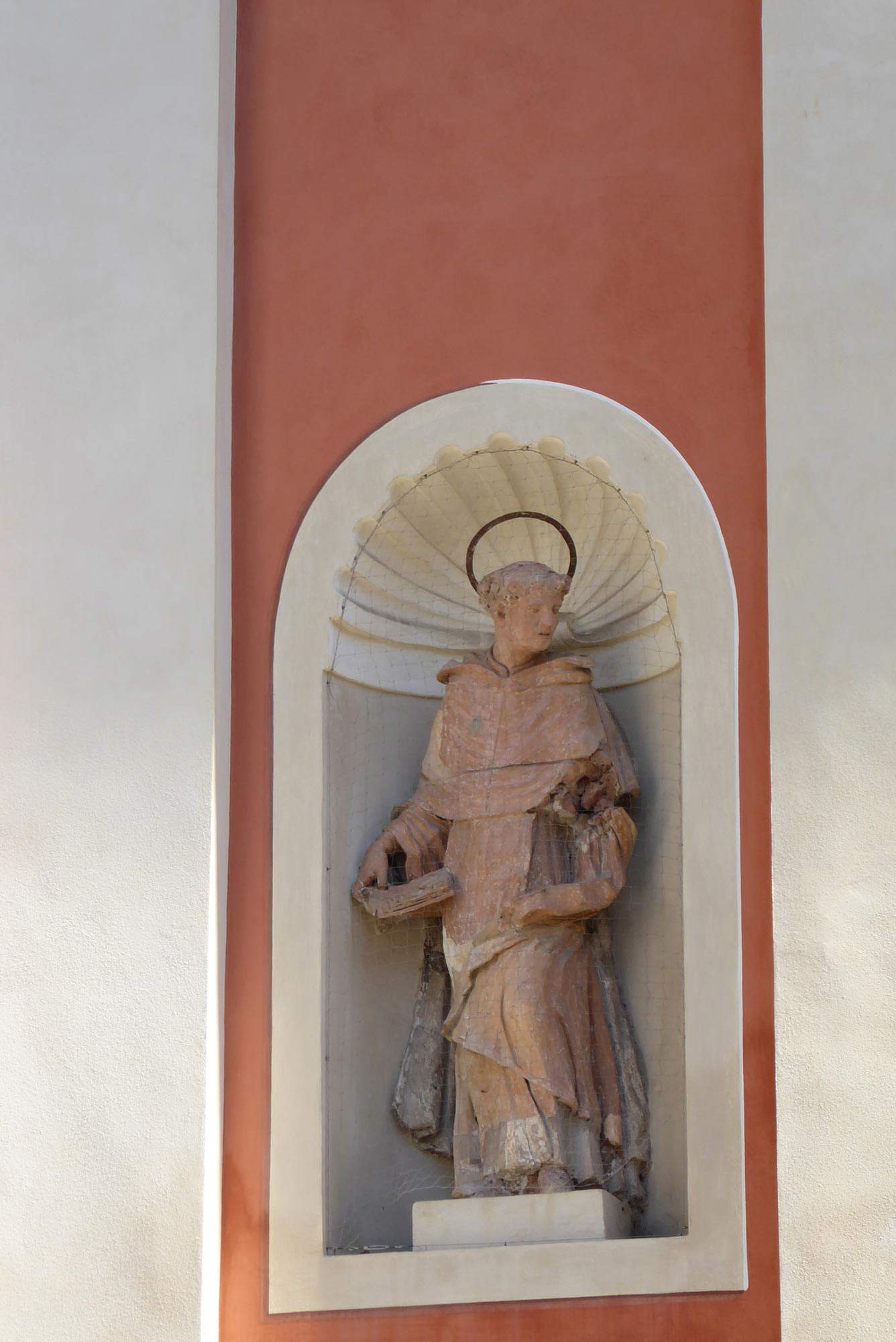 |
| Dominican Church. The statues on the façade, masterpieces of Emilian coroplastic art, already declared “very rare” by the renowned scholar Giancarlo Boiani, despite repeated reminders in past years have continued to lose their fingers, and then their hands, and now their arms and other minor parts. With book in hand here we see the statue of St. Peter Martyr, which Boiani published intact in 1980. |
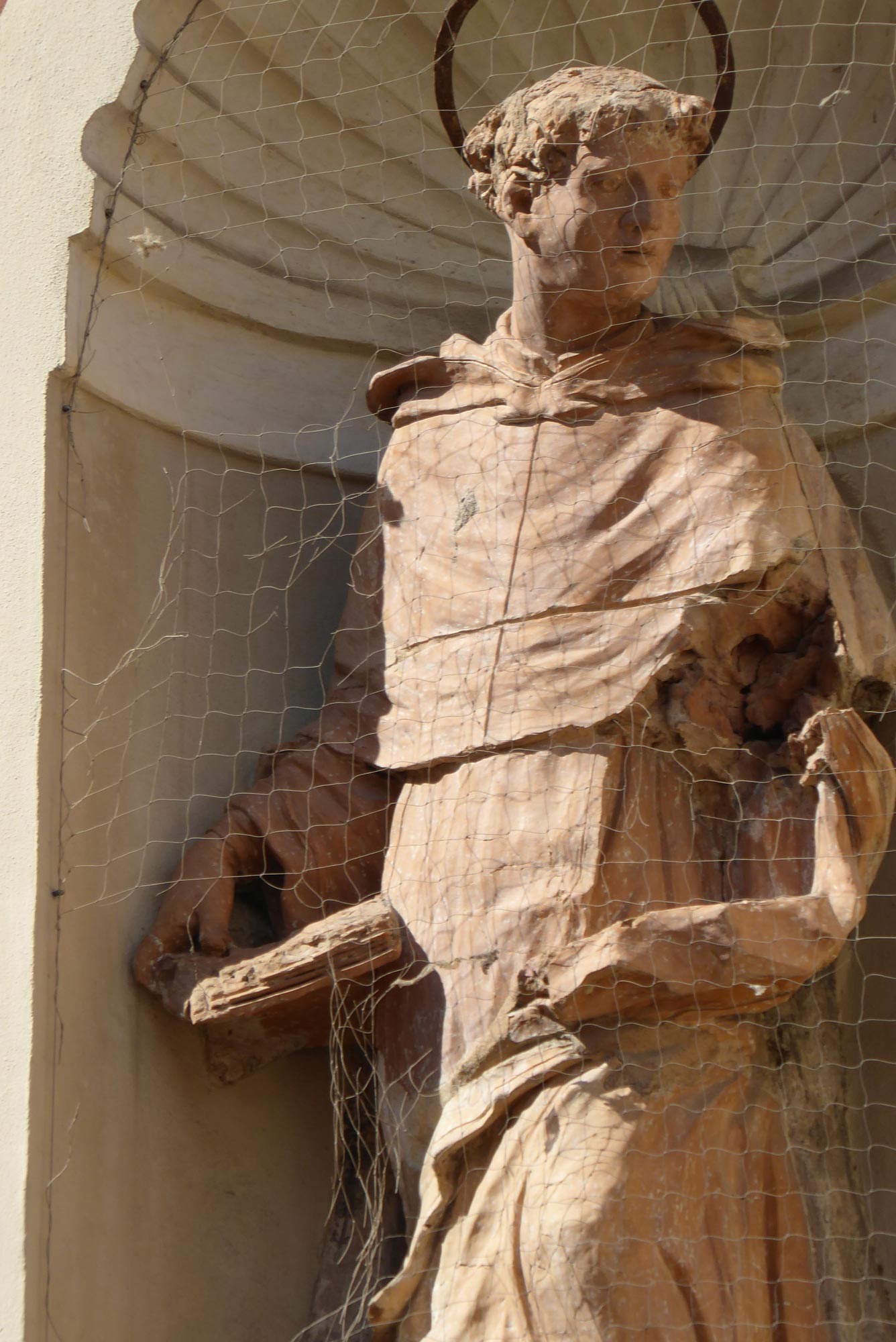 |
| Impressive detail of St. Peter Martyr, which also lost the knife on its head. |
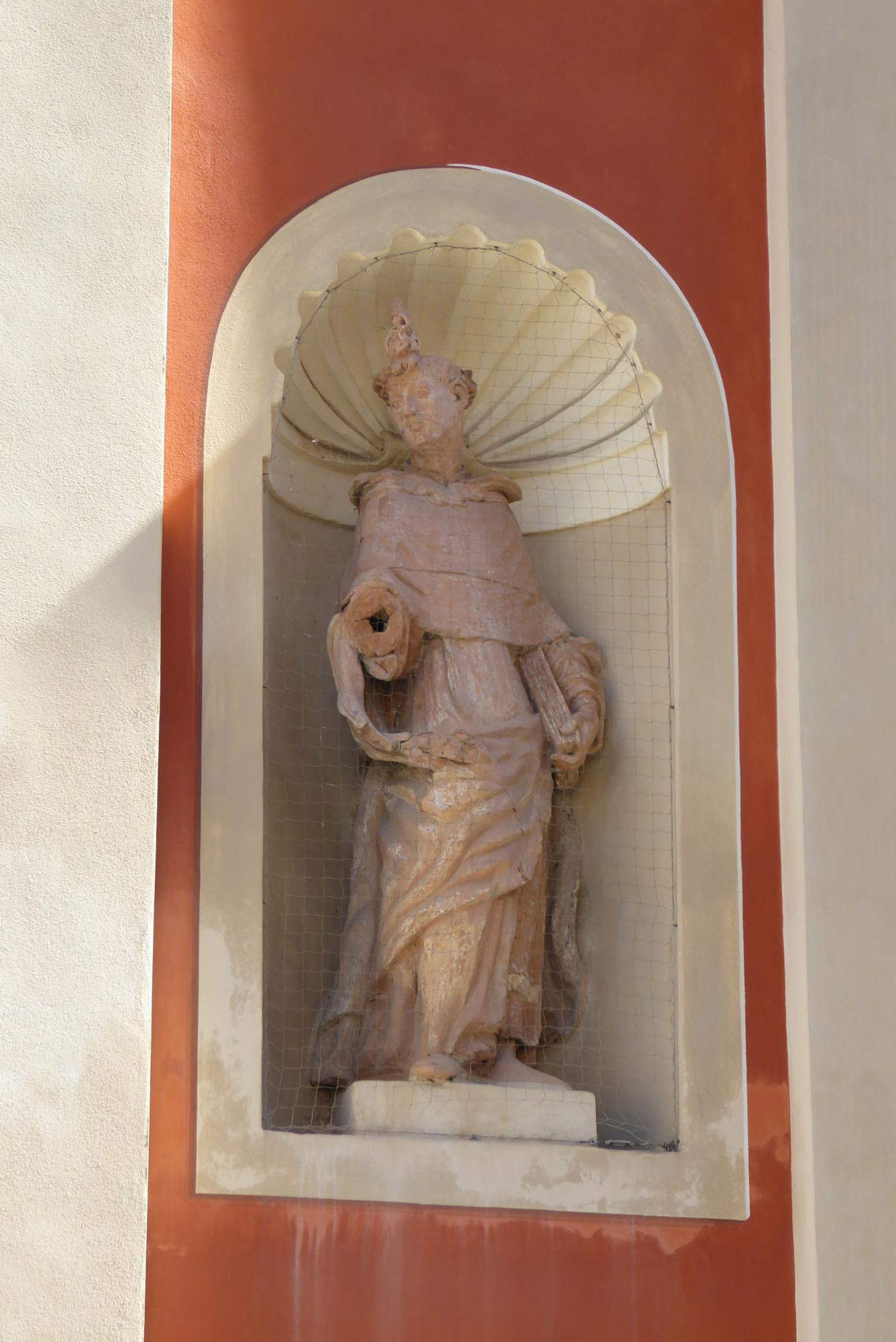 |
| The statue of St. Vincent Ferrer, which now has lost its entire forearm. |
Warning: the translation into English of the original Italian article was created using automatic tools. We undertake to review all articles, but we do not guarantee the total absence of inaccuracies in the translation due to the program. You can find the original by clicking on the ITA button. If you find any mistake,please contact us.